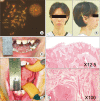Temporomandibular joint ankylosis in Williams syndrome patient: an insight on the function of elastin in temporomandibular joint disorder
- PMID: 35770360
- PMCID: PMC9247449
- DOI: 10.5125/jkaoms.2022.48.3.178
Temporomandibular joint ankylosis in Williams syndrome patient: an insight on the function of elastin in temporomandibular joint disorder
Abstract
Williams-Beuren syndrome (WS) is a rare genetic disorder that results from microdeletion at chromosome 7, which harbors the elastin gene. Clinical findings include arteriopathy, aortic stenosis, hypertension, and laxities and contractures in different joints throughout the body. While many components of the temporomandibular joint (TMJ) normally contain elastin, there are few reports on TMJ manifestations of WS. This study reports a TMJ ankylosis case in a WS patient and shares insight on a possible link between development of TMJ ankylosis and elastin deficiency in WS patients. A WS patient presented with bilateral TMJ ankylosis and was successfully treated with TMJ gap arthroplasty. Hypermobility of TMJ and lack of elastin in retrodiscal tissue can induce anterior disc displacement without reduction. Due to lack of elastin, which has a significant role in the compensatory and reparatory mechanism of TMJ, WS patients might be prone to TMJ ankylosis.
Keywords: Ankylosis; Arthroplasty; Elastin; Temporomandibular joint; Williams-Beuren syndrome.
Conflict of interest statement
No potential conflict of interest relevant to this article was reported.
Figures



Similar articles
-
Traumatic temporomandibular joint ankylosis: our classification and treatment experience.J Oral Maxillofac Surg. 2011 Jun;69(6):1600-7. doi: 10.1016/j.joms.2010.07.070. Epub 2011 Feb 5. J Oral Maxillofac Surg. 2011. PMID: 21295900
-
Novel hypotheses related to Temporomandibular joint derived from Ankylosing spondylitis.Med Hypotheses. 2020 Nov;144:110225. doi: 10.1016/j.mehy.2020.110225. Epub 2020 Sep 2. Med Hypotheses. 2020. PMID: 33254532
-
The sequential treatment of temporomandibular joint ankylosis with secondary deformities by distraction osteogenesis and arthroplasty or TMJ reconstruction.Int J Oral Maxillofac Surg. 2018 Aug;47(8):1052-1059. doi: 10.1016/j.ijom.2018.01.022. Epub 2018 Apr 27. Int J Oral Maxillofac Surg. 2018. PMID: 29706239
-
How do I manage restricted mouth opening secondary to problems with the temporomandibular joint?Br J Oral Maxillofac Surg. 2013 Sep;51(6):469-72. doi: 10.1016/j.bjoms.2012.12.004. Epub 2013 Feb 12. Br J Oral Maxillofac Surg. 2013. PMID: 23411470 Review.
-
Ankylosis of the Temporomandibular Joint in Pediatric Patients.J Craniofac Surg. 2019 Jun;30(4):1033-1038. doi: 10.1097/SCS.0000000000005547. J Craniofac Surg. 2019. PMID: 31163568
Cited by
-
The association between traumatic temporomandibular joint bony ankylosis and depressive disorder in growing rats.BMC Oral Health. 2025 Apr 11;25(1):541. doi: 10.1186/s12903-025-05886-7. BMC Oral Health. 2025. PMID: 40217243 Free PMC article.
References
-
- Martens MA, Wilson SJ, Reutens DC. Research review: Williams syndrome: a critical review of the cognitive, behavioral, and neuroanatomical phenotype. J Child Psychol Psychiatry. 2008;49:576–608. doi: 10.1111/j.1469-7610.2008.01887.x. https://doi.org/10.1111/j.1469-7610.2008.01887.x. - DOI - PubMed
-
- Copes LE, Pober BR, Terilli CA. Description of common musculoskeletal findings in Williams syndrome and implications for therapies. Clin Anat. 2016;29:578–89. doi: 10.1002/ca.22685. https://doi.org/10.1002/ca.22685. - DOI - PubMed
-
- Coombs MC, Petersen JM, Wright GJ, Lu SH, Damon BJ, Yao H. Structure-function relationships of temporomandibular retrodiscal tissue. J Dent Res. 2017;96:647–53. doi: 10.1177/0022034517696458. https://doi.org/10.1177/0022034517696458. - DOI - PMC - PubMed
-
- Leonardi R, Villari L, Bernasconi G, Caltabiano M. Histochemical study of the elastic fibers in pathologic human temporomandibular joint discs. J Oral Maxillofac Surg. 2001;59:1186–92. doi: 10.1053/joms.2001.26723. https://doi.org/10.1053/joms.2001.26723. - DOI - PubMed
-
- Keith DA. Elastin in the bovine mandibular joint. Arch Oral Biol. 1979;24:211–5. doi: 10.1016/0003-9969(79)90142-0. https://doi.org/10.1016/0003-9969(79)90142-0. - DOI - PubMed
Publication types
LinkOut - more resources
Full Text Sources
Miscellaneous

